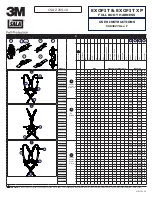
Linear Acoustic LA-5180 Metadata Frame Sync/Generator Operation Manual
Metadata
47
lower than the other main channels. This causes the film mixers to record the sur-
rounds louder (it sounds quieter, so they turn up the level to compensate), and a film
soundtrack played directly into a consumer system will have surrounds 3 dB too loud.
Not that many consumers will complain, but it is technically not correct and should be
compensated for. Compensation can be done during the television transfer (lower the
surround tracks by 3 dB), but there is also a metadata parameter that can be flagged
and it will be taken care of automatically by the Dolby Digital encoder.
•
The Dolby Digital (AC-3) system is capable of passing audio from 20 Hz to 20 KHz
from all main channels, but it is unlikely that many consumers have speakers that can
reproduce this range. Therefore, home theatre systems can send the low frequency in-
formation from the main channels, which cannot reproduce them, to the subwoofer,
which can. This is called Bass Management and television transfers should be checked
for compatibility.
7.4.3
Sitcom
Many sitcom's have been mixed in surround for over a decade. It is common practice, and
the transition to 5.1 channel surround for these facilities should be relatively straightfor-
ward. The only new additions are the storage of 5.1 channels (remember that surround
mixes are stored as 2-channel LtRt), and creation and storage of metadata. Experience has
shown that the creation of metadata has not hampered or greatly complicated standard
mixing practices.
As with other genres, the key parameter to be adjusted during sitcom mixing is dialog level.
Testing of unprocessed material (no compression or limiting) from a few of the major net-
works has shown that a typical sitcom dialnorm value is in the range of -24 to -27, but of
course this needs to be checked on a program-by-program basis.
7.4.4
News
Because of its day-to-day consistency, the news broadcast is probably the simplest case of
all. Metadata can literally be set once to match the mixing practices of that show, and likely
not ever change. The values shown in the table at the end of this section can be plugged
in, dialnorm can be checked, and the program can continue to be mixed exactly the way it
is today. Again, the only issue is making sure that the metadata travels in sync with the au-
dio data whether it is in a compressed or baseband environment.
7.4.5
SAP
The Secondary Audio Program usually carries an alternate language version of the main
program. In NTSC, the SAP is transmitted as a mono subcarrier with severe performance
limitations. The ATSC system provides the capability for sending a separate program that
in theory could be up to 5.1 channels of audio with full frequency response and dynamic
range. Typically, however, the program will be stereo or mono but will still have full fre-
quency response and dynamic range- a definite advantage over previous systems.
Summary of Contents for MetaMAXLA-5180
Page 1: ...Model LA 5180 MetaMAX Series Audio Metadata Frame Synchronizer and Generator Operation Manual...
Page 2: ......
Page 8: ...Linear Acoustic LA 5180 Metadata Frame Sync Generator Operation Manual viii...
Page 12: ...Linear Acoustic LA 5180 Metadata Frame Sync Generator Operation Manual Introduction 8...
Page 16: ...Linear Acoustic LA 5180 Metadata Frame Sync Generator Operation Manual Connections 12...
Page 20: ...Linear Acoustic LA 5180 Metadata Frame Sync Generator Operation Manual Applications 16...
Page 26: ...Linear Acoustic LA 5180 Metadata Frame Sync Generator Operation Manual Menus 22...
Page 54: ...Linear Acoustic LA 5180 Metadata Frame Sync Generator Operation Manual Metadata 50...




































